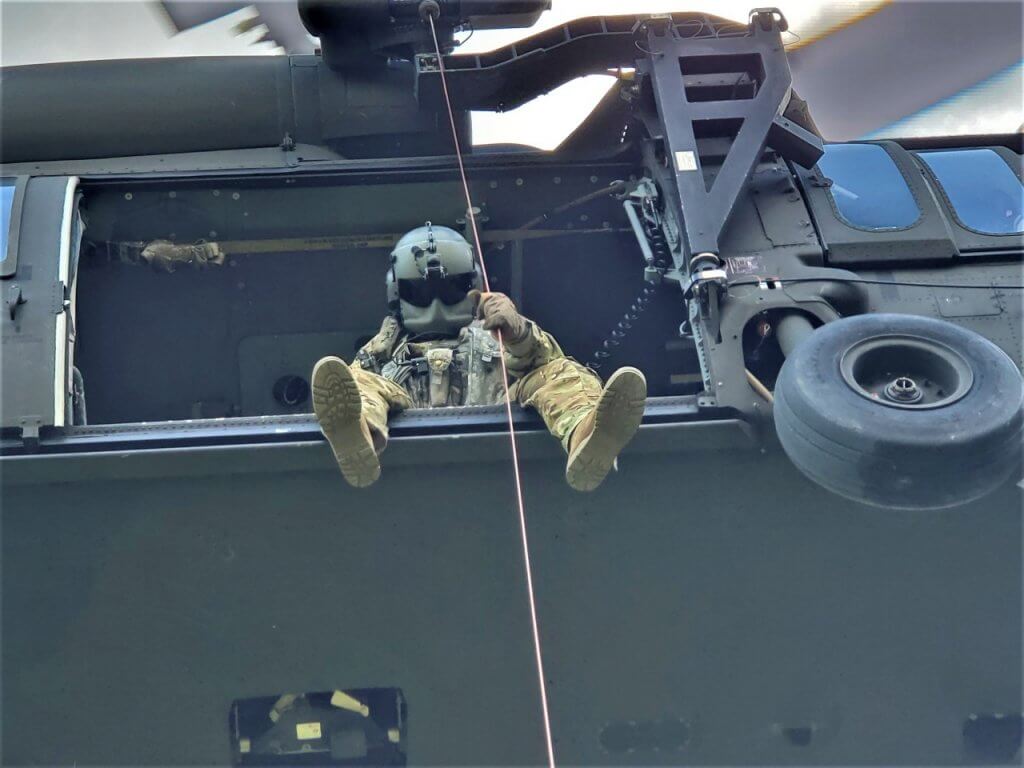All the training in the world can’t always prepare a military rescue crew for what they’ll encounter in real-life emergencies. But one Tennessee National Guard flight crew discovered that mission success hinges on communication, trust and teamwork.
Knoxville’s Detachment 1, Company C, 1-171st Aviation Regiment received a call for assistance in the early morning of the newest federal holiday, Juneteenth. The crew was at home with the day off.
A team assembled and took off in a UH-60 Blackhawk helicopter to the emergency site in about an hour. The call for help came from deep in the woods of Great Smoky Mountains National Park. A teenage girl had been attacked by a bear while camping, and suffered injuries to her head and hands that required immediate medical care.
“The trees were so thick, and the location was a bit vague for where the campsite was,” said Capt. Philip Webster, the pilot in command. “We couldn’t see the trail or the campsite from the air.”
Landing would be impossible, so the Blackhawk got into position to lower Sgt. 1st Class Tracy Banta, a critical care flight paramedic, past the tree cover to the victim. The crew would essentially be going into this mission blind.
“From my perspective as a pilot, I was hovering about 3 feet from a pine tree in front of me, and I never could see the patient that we were lowering Sgt. Banta to,” Webster said. “It was that thick, and we were approximately 150 feet off the ground.”
‘You literally have a life on the line’
The environment was more extreme than the crew’s typical training missions. The helicopter would need to hover in a confined canyon space between a gap of trees while hoisting a crew member below, out of sight from the rest of the team.
“You literally have a life on the line,” said Webster, adding that slight changes in the wind could have been disastrous. “A small movement up top can be a large movement at the bottom. It’s going to, in effect, swing (the crew member) into a tree, rock, obstacle or potentially get them tangled.”
RELATED: Alaska National Guard rescues 12 stranded mountaineers
According to Webster, the aircraft’s direction falls on the communications that come from the rear of the helicopter where the hoisting operations are taking place.
“It’s extremely important to have faith in each other,” he said.
The crew lowered Banta into the unknown. Once the flight paramedic went through the tree foliage, the team relied on radios to communicate.
“We can’t train for everything that we’re going to encounter,” Banta said. “Thank the Lord everything was on our side, and everyone was safe, and we were able to get in and get out.”
Park rangers provided initial medical care to the victim, and Banta was able to hoist the girl onto the helicopter without complications. The entire mission took just 14 minutes. And 20 minutes later, the teenage victim arrived at the University of Tennessee Medical Center in Knoxville.
A ‘good perspective’ meeting bear attack victim
She has since made a full recovery and met her rescuers for a reunion earlier this month. She and her family thanked the National Guard aircrew and park rangers, and toured the Blackhawk aircraft. The meeting was memorable for the team because they often don’t catch up with the people they rescue.
“To be able to see her, fully recovered and smiling, enjoying the crew and making jokes with everyone was really rewarding,” Webster said.
The men were moved by a special gift the victim presented to each of her rescuers – a wood-burned ornament with an image of a bear. Wood-burning was part of the teenager’s rehabilitation process to get back movement in her injured hand.
The rescuers also received a letter from the victim’s grandmother, praising them for giving her a chance to grow up, attend college and potentially start a family of her own one day.
“When you’re going out on a rescue, you don’t think about the future of somebody a lot of times,” Banta said. “You’re thinking of the here and now; you don’t get a chance to go back, so it was a good perspective to see this and get those ornaments, and of all things, a bear.”
The other flight crew members were Pilot Chief Warrant Officer 3 Andrew Redley and Crew Chief Sgt. Tim Allen.
June’s bear attack rescue was the Tennessee National Guard Detachment 1, Company C, 1-171st Aviation Regiment’s sixth rescue of 2021. The regiment has conducted 30 rescues since the Blackhawk helicopter came to Eastern Tennessee in 2016.

